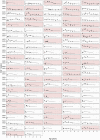Healthy dynamics of CD4 T cells may drive HIV resurgence in perinatally-infected infants on antiretroviral therapy
- PMID: 35969641
- PMCID: PMC9410541
- DOI: 10.1371/journal.ppat.1010751
Healthy dynamics of CD4 T cells may drive HIV resurgence in perinatally-infected infants on antiretroviral therapy
Abstract
In 2019 there were 490,000 children under five living with HIV. Understanding the dynamics of HIV suppression and rebound in this age group is crucial to optimizing treatment strategies and increasing the likelihood of infants achieving and sustaining viral suppression. Here we studied data from a cohort of 122 perinatally-infected infants who initiated antiretroviral treatment (ART) early after birth and were followed for up to four years. These data included longitudinal measurements of viral load (VL) and CD4 T cell numbers, together with information regarding treatment adherence. We previously showed that the dynamics of HIV decline in 53 of these infants who suppressed VL within one year were similar to those in adults. However, in extending our analysis to all 122 infants, we find that a deterministic model of HIV infection in adults cannot explain the full diversity in infant trajectories. We therefore adapt this model to include imperfect ART adherence and natural CD4 T cell decline and reconstitution processes in infants. We find that individual variation in both processes must be included to obtain the best fits. We also find that infants with faster rates of CD4 reconstitution on ART were more likely to experience resurgences in VL. Overall, our findings highlight the importance of combining mathematical modeling with clinical data to disentangle the role of natural immune processes and viral dynamics during HIV infection.
Conflict of interest statement
The authors have declared that no competing interests exist.
Figures




Similar articles
-
Time to Viral Suppression in Perinatally HIV-Infected Infants Depends on the Viral Load and CD4 T-Cell Percentage at the Start of Treatment.J Acquir Immune Defic Syndr. 2020 Apr 15;83(5):522-529. doi: 10.1097/QAI.0000000000002291. J Acquir Immune Defic Syndr. 2020. PMID: 31917752 Free PMC article.
-
Quantifying the Dynamics of HIV Decline in Perinatally Infected Neonates on Antiretroviral Therapy.J Acquir Immune Defic Syndr. 2020 Oct 1;85(2):209-218. doi: 10.1097/QAI.0000000000002425. J Acquir Immune Defic Syndr. 2020. PMID: 32576731 Free PMC article.
-
The effect of opportunistic illness on HIV RNA viral load and CD4+ T cell count among HIV-positive adults taking antiretroviral therapy.J Int AIDS Soc. 2013 Apr 1;16(1):17355. doi: 10.7448/IAS.16.1.17355. J Int AIDS Soc. 2013. PMID: 23547778 Free PMC article.
-
Differences in virologic and immunologic response to antiretroviral therapy among HIV-1-infected infants and children.AIDS. 2016 Nov 28;30(18):2835-2843. doi: 10.1097/QAD.0000000000001244. AIDS. 2016. PMID: 27603293 Free PMC article.
-
[Consensus document of Gesida and Spanish Secretariat for the National Plan on AIDS (SPNS) regarding combined antiretroviral treatment in adults infected by the human immunodeficiency virus (January 2012)].Enferm Infecc Microbiol Clin. 2012 Jun;30(6):e1-89. doi: 10.1016/j.eimc.2012.03.006. Epub 2012 May 23. Enferm Infecc Microbiol Clin. 2012. PMID: 22633764 Spanish.
Cited by
-
Mathematical modeling and mechanisms of HIV latency for personalized anti latency therapies.NPJ Syst Biol Appl. 2025 Jun 12;11(1):64. doi: 10.1038/s41540-025-00538-6. NPJ Syst Biol Appl. 2025. PMID: 40506472 Free PMC article. Review.
References
-
- UNAIDS data; 2020. Available from: https://www.unaids.org/en/resources/documents/2020/unaids-data.
Publication types
MeSH terms
Substances
Grants and funding
LinkOut - more resources
Full Text Sources
Medical
Research Materials

